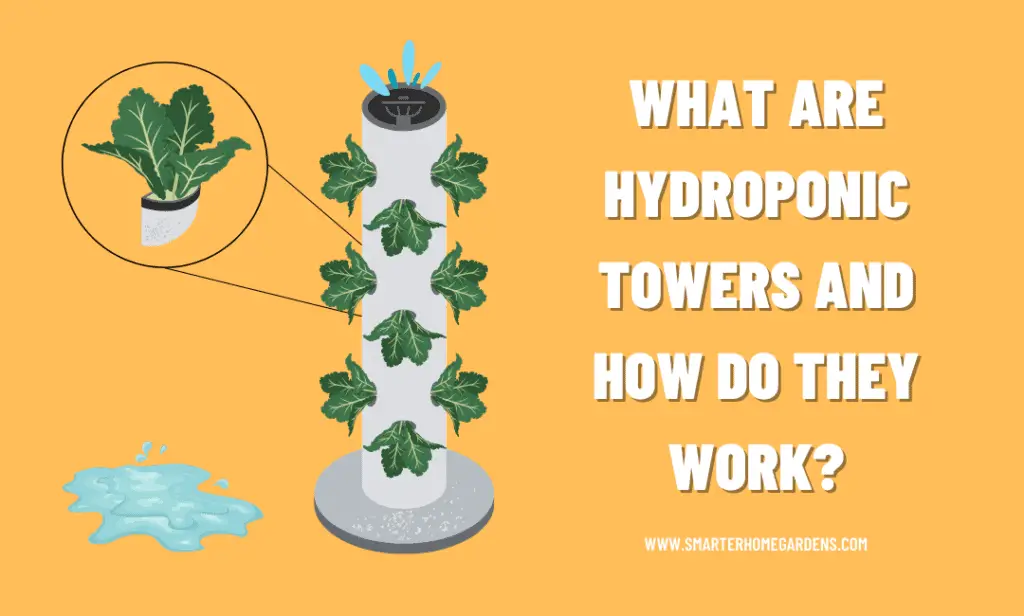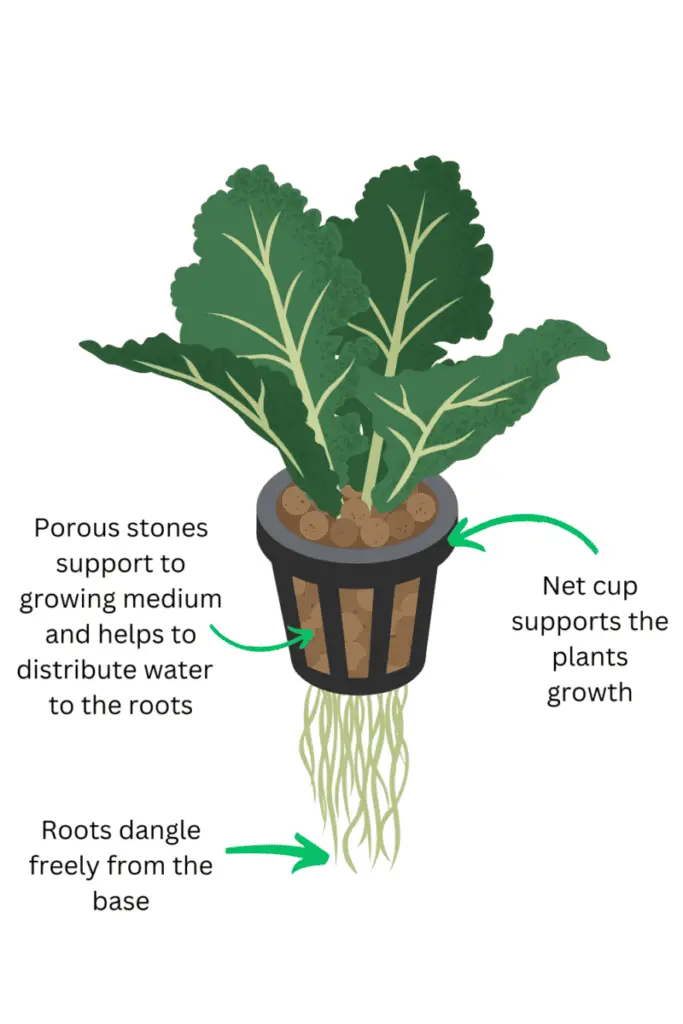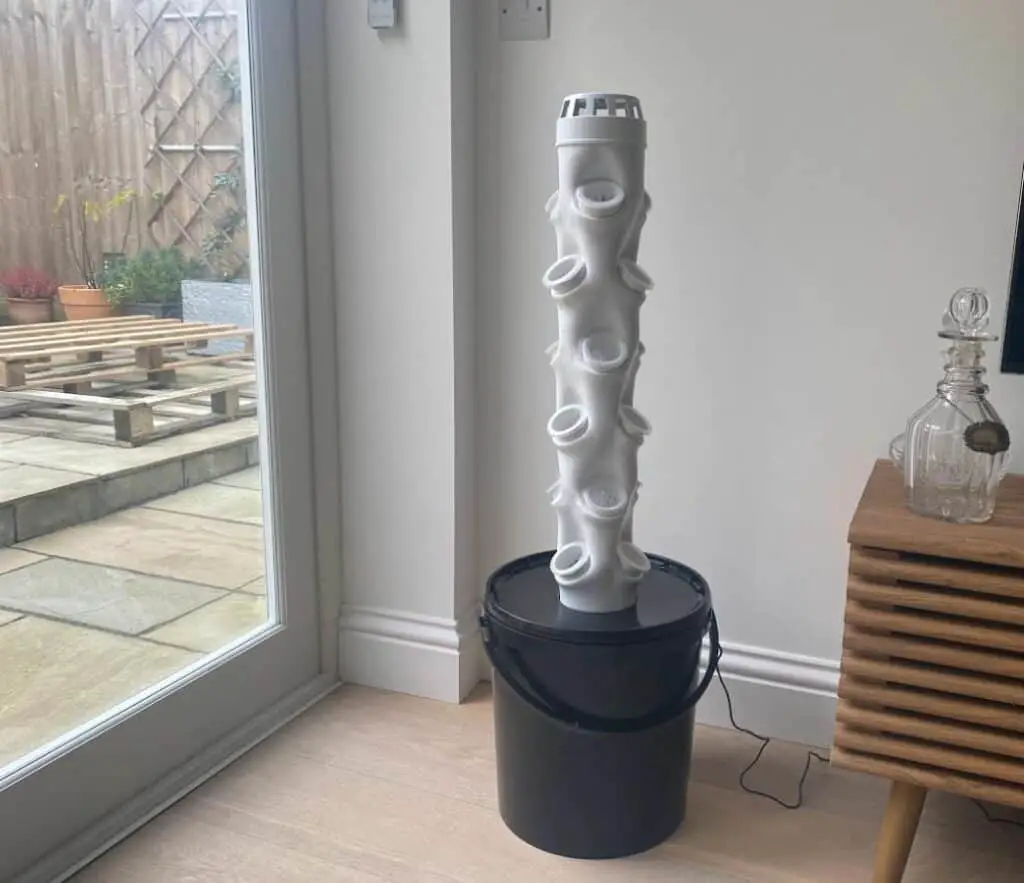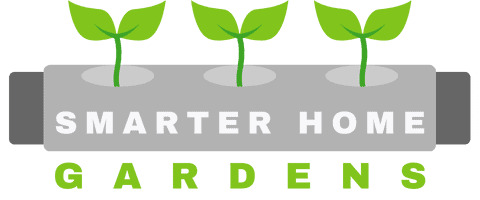This article contains affiliate links. As an Amazon Associate, SmarterHomeGardens.com earns a small commission on qualifying purchases at no extra cost to you.

Ever since I embarked on my ‘smarter’ gardening journey, I’ve been searching for innovative ways to cultivate plants. And in that quest, I stumbled upon hydroponic towers — a revelation I believe every gardening enthusiast, like you, should explore.
But what exactly are hydroponic towers and how do they work?
A hydroponic tower is a vertical growing system in which plants are suspended in net cups instead of soil. Nutrient-rich water is pumped to the top of the tower before flowing down over the roots, ensuring each plant gets essential nutrients while maximizing space and efficiency.
Through this guide, I’ll share all that I’ve learned about hydroponic towers, ensuring that you too can master the art and joy of hydroponic tower gardening. Ready to journey with me?
What are hydroponic towers? The detail.
Hydroponic towers are one of the most space-efficient hydroponic systems out there. As such, I have found them to be a great way of growing leafy greens at home, both indoors and out.
Check out this related article: Outdoors vs. Indoor Hydroponics: Which is better?
Check out this video explanation from Tower Garden
Let’s explore exactly how they work and what makes them so great.
How does a hydroponic tower work?
A hydroponic tower is typically created using a tall, cylindrical structure with rows of holes in which to place the plants, usually supported by net cups.
A nutrient-rich water solution is pumped to the tower’s top and then trickles down over the plants’ roots, delivering essential nutrients directly for optimized growth.
Here’s a high-level diagram:

Main components and mechanisms of a hydroponic tower
There are a few different components that make up a hydroponic tower, each with its own specific function. Let’s dive into each one so that you fully understand how the tower works.
1. The reservoir
The reservoir is usually made from a food-safe bucket ranging anywhere from 10 to 60 liters. It is used for storing the nutrient solution. The reservoir also houses the water pump.
2. Water pump
This facilitates the movement of the nutrient solution from the reservoir to the top of the tower. The size of the hydroponic tower will determine the size of the pump needed.
Some of the best Water Pumps I can recommend are:
3. Water hose
These guide the nutrient solution from the top of the tower, ensuring it reaches all the plants as it flows downwards.
4. The tower structure
The central vertical framework that holds the entire system. The tower structure can range anywhere from 0.5m to 3m in height and is usually made from food-grade PVC pipe or can be 3D printed using food-safe material.
5. Net cups
Small containers that hold the plant and its medium in place on the tower. The net cups allow nutrient water to pass through and soak the plant’s roots.

You can buy net cups easily and cheaply on Amazon.
6. Growing medium
An inert substance, such as rock wool, perlite, or coco coir, replaces soil (most vertical gardens do not need to use soil). It anchors the plant roots and supports their growth.
The growing medium is supported by porous stones, usually clay, that help to absorb and distribute nutrient-rich water to the roots.
7. Perforated nozzle
At the top of the water hose is a perforated nozzle that ensures water is spread across the tower evenly as it descends. This is important so that all plants receive water and nutrients evenly.
8. Artificial light source
If the tower is indoors or in a low-light environment, artificial grow lights may be needed to provide the plants with the necessary light for photosynthesis.
Top tip: It is really important to keep your vertical tower clean. If you want to know how you can read my detailed step-by-step guide.
What are the benefits of a hydroponic tower?
Now that you understand what a hydroponic tower is and how it works, why should you build one? Well, there are many benefits to growing plants in a hydroponic tower, some of which I have listed below.

Efficient use of space
- Vertical Growth: Given their upward structure, hydroponic towers are perfect for areas with limited horizontal space, like balconies, patios, or small yards. Check out this article on the benefits of vertical gardening.
- Dense Planting: Their design allows for closer plant spacing, yielding more crops per square foot than traditional methods.
Consistent and accelerated growth
- Direct Nutrient Delivery: With plants receiving nutrients directly from the water, there’s typically faster growth and more robust yields. However, the nutrient solution needs to be replaced regularly.
- Controlled Environment: With external factors minimized, plants often experience fewer diseases and pests, ensuring healthier growth.
Water and resource efficiency
- Recirculation: Most hydroponic tower systems recycle water, leading to up to 90% less water use compared to traditional soil gardening.
- Precise Nutrient Management: By controlling the nutrient mix, there’s minimal wastage, ensuring plants get exactly what they need.
Flexibility and Scalability
- Indoor/Outdoor: Depending on the design, these towers can function both indoors (with appropriate lighting) and outdoors.
- Expandability: Many systems are modular, allowing growers to easily expand their setup as needed.
Clean and sustainable
- Soil-less: The absence of soil means less mess, reducing the chance of soil-borne diseases. However, hydroponics systems are still susceptible to algae growth and build-up of mold if not properly maintained.
- Eco-friendly: Efficient resource use, especially water, makes hydroponic towers a more sustainable choice for the environment.

Common problems with hydroponic towers
There are, however, some problems with hydroponic towers when compared with other types of hydroponics systems. Some of the problems I have found with my hydroponics towers are:
1. Difficulty cleaning
The tower structure can be difficult to clean, especially if the structure is not modular and therefore cannot be taken apart. Algae growth can therefore be a problem if you don’t clean your system regularly.
Check out my article on preventing and removing algae from a hydroponics system.
2. Difficult to light artificially
I’ve vertical hydroponic towers to be harder to light artificially due to their height and vertical nature. Other types of systems can be slotted into racks or shelving with lights above.
Towers also require light to be emitted 360 degrees which creates additional complexity. If they’re not, then you will need to rotate your hydroponic tower to ensure even plant growth.
3. Problems with the pump
The size of the pump will be determined by the height of the system. You’ll need a pump large enough to pump the nutrient solution to the top of the tower.
Additional height can put pressure on the pump which can cause it to fail. Furthermore, any pump runs the risk of malfunction if not properly maintained.
4. Electricity use
Hydroponic towers are ‘active’ hydroponic systems, meaning that water is pumped around the system to feed the plants. This requires a pump, which requires electricity. When artificial lights are added this further increases the energy use required to run the system.
Check out my article on how much electricity a hydroponic system uses.
5. High initial costs
Purchasing or building your own hydroponic tower isn’t cheap. This is largely down to the materials required to create a hydroponic tower and the complexity of construction.
I purchased my two hydroponic towers from Vertical Horizon for a total of $350.
Generally, it’ll cost between $100-$300 to either buy or create a vertical tower system.
6. Plant compatibility
Hydroponic towers are fantastic for growing leafy greens. While it is possible to grow fruits and vegetables in a hydroponic tower, the vertical nature of the structure makes this more difficult. In particular, root vegetables, heavily vining plants, and heavy plants are not well suited.
There are many issues and challenges with hydroponics in general. For an in-depth look at some of them, read my article 19 Common Problems with Hydroponics And How To Fix Them.

To reduce the chances of something going wrong, make sure you know how to maintain your hydroponic tower system properly. Read my linked article for more info on that.
What are the best plants to grow in a hydroponic tower?
I’ve written a whole article where I review my top 10 best plants to grow in a hydroponic tower. However, there are many more than that! The best plants to grow in a hydroponic tower are usually leaf greens and herbs because of their lightweight, short growth cycle, and shallow root systems. But, you can grow heavier fruits too!
Here are 54 examples of plants that work great on hydroponic towers

In conclusion
Hydroponic towers have carved out a significant niche, especially for hobbyists navigating space constraints. These vertical, soil-less marvels, relying on nutrient-rich water solutions, signify a union of innovation with traditional cultivation practices.
While the advantages are undeniable – from spatial efficiency to rapid growth and sustainable water use – it’s essential for enthusiasts to remain aware of challenges like cost, what they can and can’t grow, or equipment maintenance.

As with any gardening approach, success lies in understanding, regular maintenance, and adaptability.
Learn how to Prevent and Remove Mold from a Hydroponics System.
As we’ve delved into the intricacies of hydroponic towers, one thing remains clear: they present a forward-thinking method that bridges the gap between nature and technology, heralding a promising future for garden enthusiasts everywhere.
